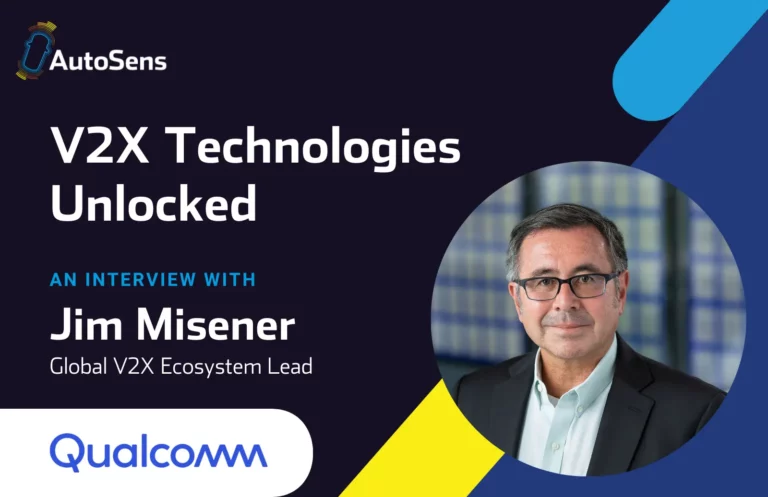What system level challenges does the increasing level of compute and sensors now demanded for modern vehicles present? In this article, Shashank Dabral, Lead Platform Architect at Rivian, explores this in the context of body design, sensor cleaning, the camera harness – and the costs of this level of innovation. Shashank highlights key sessions for each feature that are not to be missed at AutoSens Brussels.
The last few years have seen significant advancements in the field of autonomous and semi-autonomous driving. With the help of government backed standardization bodies (e.g., NCAP in the Europe region and NHTSA in the US) along with consumer awareness, the benefit and demand of autonomy is steadily on the rise. With the emergence of operating domain (ODD) limited L3 features already on the market, every automaker is pushing the envelope on the autonomy offerings ranging from simple L1 autonomy on entry level vehicles to varying sophistication of L2+ features targeting both longitudinal and lateral control in a variety of ODDs (Such as day, night, adverse weather, varying road surfaces etc.).
The increased demand for autonomy has led to an exponential increase in both the compute cluster as well as the demands on the sensor constellation. This blog post explores some of the system level challenges that arise with the increase in the level of compute and sensors that are now appearing in modern vehicles.
THE ROAD TO AUTONOMOUS CARS: TECHNOLOGY, ECOSYSTEM, AND MARKET REVIEW
- 12:30pm CET
- Thursday 21st September
- Mahy Room

Michele Richichi
Principal Analyst – Europe | Supply Chain & Technology | Autonomy (ADAS & Autonomous Driving)
S&P Global Mobility
Body Design vs Autonomy
Even though autonomy features are significantly influencing consumer purchase decisions, vehicle design still dominates and plays a key role in the buying process. Most sensors (with the notable exception of Radars) including cameras, Lidars and ultrasonics require a line of sight to operate and as such are mounted on the exterior surfaces of the vehicle. However, the same property that lets these sensors view the external world (i.e., their mounting location) also makes them visible to an external observer and creates an unavoidable conflict. Design philosophies prioritize clean unbroken surfaces and as such a visible sensor placed in the middle of such a surface is considered detrimental. Consequently, there is a desire to conceal sensors from an external observer. This becomes increasingly challenging when we have to account for various body colors (Consider the challenges of concealing a camera on a black car vs a bright red one) as well as bigger sensors (higher levels of autonomy leading to longer detection range which corresponds to higher resolution and even larger optics). Some critical camera sensors are also mounted inside the cabin (typically behind the windshield) and as such their enclosure and its appearance needs to be considered in the overall design.
As we start including active emitter sensors such as Lidars, the size grows drastically, and newer mounting positions have to be considered. Various mounting positions have been proposed lately with the mounting on the roof being the most common, however it does have a detrimental effect to the overall streamlining of the body.
In summary, the typical development flow places a greater emphasis on evaluating the sensor properties (Resolution, power, detection range etc.) without considering the aesthetics behind it which leads to multiple iterations with the studio and a longer development cycle. Involving the design studio team from the start can mitigate this problem and help in reducing the overall design cycle.
To clean or not to clean
The sensors mounted behind the windshield have an added advantage that they are not exposed to the elements, and they are typically mounted in a way such that their field-of-view cone is within the arc of the windshield wiper blades. However, sensors mounted on the exterior surfaces are not so fortunate. These sensors are susceptible to blockage due to environmental conditions such as rain drops, ice/snow or simply just dust. As we gradually transition to higher levels of autonomy, it is imperative that the sensors are maintained in impeccable operating state. A dirty /obstructed lens can cause an object detection algorithm to fail in detecting a vehicle or pedestrian leading to a dangerous driving condition.
The need of the hour at the bare minimum is to enable monitoring functions that continuously monitor the state and health of the sensor and disable the autonomy features when an obstruction is detected. However, the user experience can vary greatly based on the expectations from the user after an obstruction is detected. Consider the example of a driver on a long road trip under adverse weather or environmental conditions (such as a dusty road). Under such conditions, the cameras may be getting soiled every 15-20 minutes, however it may be impractical to expect the driver to stop the vehicle, manually clean the sensors and continue driving especially if the frequency of occurrence is high.
To mitigate such scenarios, there is an increased effort to develop self-cleaning systems. Some of the most popular ones include using a washer nozzle solution with either liquid, air or a mix of the two, using ultrasonic vibrations, centrifugal force or even sound waves to dissipate the obstructing particles. However, each of these solutions do come with their own set of tradeoffs. Using a nozzle and washer solution can lead to increase in cost based not only on the cost of the nozzle but also the cost of the piping required to go from the fluid bottle to each of the independent sensors. Further, frequent use of the cleaning system may run the fluid bottle dry frequently thereby leading to larger bottle design which again needs to factor in the constraints of space and weight. Using ultrasonic vibrations or centrifugal based solutions solves the fluid capacity and piping issues but does lead to higher cost and larger sensor size which again violates the ‘clean’ design philosophy that focuses on creating unbroken surfaces.
Sensor cleaning continues to be an actively researched field and there is no one solution fits all. The design philosophy, user preferences and operating domain need to be factored in while selecting the optimal solution.
ANALYSIS OF WEATHER EFFECTS ON SENSOR PERFORMANCE FOR IMPROVING IMAGE QUALITY
- 2:15pm CET
- Wednesday 20th September
- Mezzanine Stage

Armin Engstle
Main Department Manager
AVL Software and Functions GmbH
ASSURING AUTONOMOUS VEHICLES: SENSOR WEATHER DEGRADATION
- 2:40pm CET
- Wednesday 20th September
- Mezzanine Stage

Dr Richard Dudley
Science Area Leader (Autonomous Vehicle Sensors, Electromagnetics & Precision Farming)
National Physical Laboratory
Harness Challenges
With the advancement of sensors, there is a corresponding increase in the data rate associated with data transmission. Typical radars that could easily be connected via CAN-FD have now transitioned to 100 Mbps ethernet and Lidars can frequently require up to 1 Gbps ethernet link (Though data rates maybe typically lower than that the limit). However, the harnessing challenge becomes extremely severe with cameras.
A typical 8 M-pix camera running at 30 fps requires a peak data rate close to 4 Gbps and even though solutions have existed in the market for years, the cost and weight of the cables and connectors can be significant. An example that stood out from my prior experience while working at Texas Instruments Inc (TI) was when we were designing an early generation of Camera Monitoring System (CMS) with a leading Tier-1. TI solutions were already market leading in terms of cost and features, yet there was a need to cost optimize the solution and use a single Processor from TI to support both the left and the right cameras. However, a deeper analysis and cost breakdown revealed that the cost of additional harnessing to support the architecture would overshadow the cost savings of removing a processor from the system thereby highlighting the importance of harnessing in system design. In current generation vehicles, it’s common for the camera harness cost to be a significant percentage of the full camera module, especially for cables that have to transition across multiple harness sections. It is imperative therefore, to design the placement of sensors and the compute ECU to optimize the harness cost / size.
FUTURE-PROOF CONNECTIVITY FOR IMAGING SENSORS
- 9:15am CET
- Wednesday 20th September
- Mezzanine Stage

Christoph Gollob
Network Architect
BMW Group
The cost of innovation
The last section on this blog highlights the challenges faced by OEMs and Tier-1s as they try to differentiate with innovation. One of the key problems associated with a novel solution is that it’s a first to the market and typically has to bear the cost of initial R&D / Non-Recurring Engineering (NRE) as well as factor typically lower volumes into account. It’s common to see an increase in cost by a multiple of 2-4x for mechanical parts (such as door grommets/connectors etc.) as well as electronic components (SoCs, sensors etc.), when using a state-of-the-art solution. As such, effort should be made to architect the system to stress on reusing as many components as possible.
The article highlights some of the challenges faced by system architects in designing system with high levels of autonomy in modern vehicles. The views expressed in the article are that of the author alone and do not reflect the opinions of any current or past employers.
ADAS AND AV SENSOR SUITE: EMERGING DEVELOPMENTS AND PRICING TRENDS
- 11:15am CET
- Thursday 21st September
- Mahy Room

Asif Anwar
Executive Director – Automotive End-Market Analysis
TechInsights








